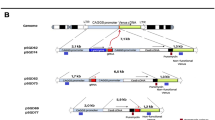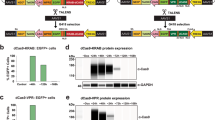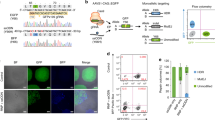Abstract
Gene repair, the precise modification of the genome, offers a number of advantages over replacement gene therapy. In practice, gene targeting strategies are limited by the inefficiency of homologous recombination in mammalian cells. A number of strategies, including RNA-DNA oligonucleotides (RDOs) and short DNA fragments (SDFs), show promise in improving the efficiency of gene correction. We are using GFP as a reporter for gene repair in living cells. A single base substitution was introduced into GFP to create a nonsense mutation (STOP codon, W399X). RDOs and SDFs are used to repair this mutation episomally in transient transfections and restore green fluorescence. The correction efficiency is determined by FACS analysis. SDFs appear to correct GFP W399X in a number of different cell lines (COS7, A549, HT1080, HuH-7), although all at a similar low frequency (∼0.6% of transfected cells). RDOs correct only one of our cell lines significantly (HT1080-RAD51), these cells overexpress the human RAD51 gene; the bacterial RecA homologue. The GFP W399X reporter is a fusion gene with hygromycin (at the 5′ end), this has allowed us to make stable cell lines (A549, HT1080) to study genomic correction. Initial studies using our correction molecules show only low efficiencies of genomic repair (∽10−4). Polyethylenimine (PEI) is used to deliver RDOs and SDFs into mammalian cells in culture for our study. We have used fluorescently labelled RDOs and SDFs to study the effectiveness of this process. FACS analysis of transfected nuclei implied efficient delivery (>90%) both with SDFs and RDOs. However, confocal fluorescence microscopy suggests that a large proportion of the complexed RDO/SDF appears to remain outside the nucleus (or attached to the nuclear membrane). On the basis of these data we are assessing new delivery methods and factors that may alter recombination status to optimise gene repair.
This is a preview of subscription content, access via your institution
Access options
Subscribe to this journal
Receive 12 print issues and online access
$259.00 per year
only $21.58 per issue
Buy this article
- Purchase on Springer Link
- Instant access to full article PDF
Prices may be subject to local taxes which are calculated during checkout

Similar content being viewed by others
References
Bigger B, Coutelle C . Perspectives on gene therapy for cystic fibrosis airway disease BioDrugs 2001 15: 615–634
Davis JC, Geddes DM, Alton EW . Gene therapy for cystic fibrosis J Gene Med 2001 3: 409–417
Flotte TR, Laube BL . Gene therapy in cystic fibrosis Chest 2001 120: 1245–1315
Griesenbach U, Alton EWFW . Recent progress in gene therapy for cystic fibrosis Curr Opin Mol Ther 2001 3: 385–389
Yáñez RJ, Porter ACG . Therapeutic gene targeting Gene Therapy 1998 5: 149–159
Richardson PD, Kren BT, Steer CJ . Targeted gene correction strategies Curr Opin Mol Ther 2001 3: 327–337
Kunzelmann K et al. Gene targeting of CFTR DNA in CF epithelial cells Gene Therapy 1996 3: 859–867
Goncz KK, Kunzelmann K, Xu Z, Gruenert DC . Targeted replacement of normal and mutant CFTR sequences in human airway epithelial cells using DNA fragments Hum Mol Genet 1998 7: 1913–1919
Kapsa R et al. In vivo and in vitro correction of the mdx dystrophin gene nonsense mutation by short-fragment homologous replacement Hum Gene Ther 2001 12: 629–642
Goncz KK et al. Expression of DeltaF508 CFTR in normal mouse lung after site-specific modification of CFTR sequences by SFHR Gene Therapy 2001 8: 961–965
Gamper HB et al. The DNA strand of chimeric RNA/DNA oligonucleotides can direct gene repair/conversion activity in mammalian and plant cell-free extracts Nucleic Acids Res 2000 28: 4332–4339
Gamper HB et al. A plausible mechanism for gene correction by chimeric oligonucleotides Biochem 2000 39: 5808–5816
Igoucheva O, Alexeev V, Yoon K . Targeted gene correction by small single-stranded oligonucleotides in mammalian cells Gene Therapy 2001 8: 391–399
Liu L, Rice MC, Kmiec EB . In vivo gene repair of point and frameshift mutations directed by chimeric RNA/DNA oligonucleotides and modified single-stranded oligonucleotides Nucleic Acids Res 2001 29: 4238–4250
Yoon K, Cole-Strauss A, Kmiec EB . Targeted gene correction of episomal DNA in mammalian cells mediated by a chimeric RNA/DNA oligonucleotide Proc Natl Acad Sci USA 1996 93: 2071–2076
Kren BT, Cole-Strauss A, Kmiec EB, Steer CJ . Targeted nucleotide exchange in the alkaline phosphatase gene of HuH-7 cells mediated by a chimeric RNA/DNA oligonucleotide Hepatology 1997 25: 1462–1468
Colosimo A et al. Targeted correction of a defective selectable marker gene in human epithelial cells by small DNA fragments Mol Ther 2001 3: 178–185
Inoue N et al. Introduction of single base substitutions at homologous chromosomal sequences by adeno-associated virus vectors Mol Ther 2001 3: 526–530
Cole-Stauss A et al. Targeted gene repair directed by chimeric RNA-DNA oligonucleotides in a mammalian cell-free extract Nucleic Acids Res 1999 27: 1323–3330
Igoucheva O, Peritz AE, Levy D, Yoon K . A sequence-specific correction by an RNA-DNA oligonucleotide in mammalian cells characterized by transfection and nuclear extract using lacZ shuttle system Gene Therapy 1999 6: 1960–1971
Rice MC, Bruner M, Czymmek K, Kmiec EB . In vitro and in vivo nucleotide exchange directed by chimeric RNA/DNA oligonucleotides in Saccharomyces cerevisae Mol Microbiol 2001 40: 857–868
Yáñez RJ, Porter ACG . Gene targeting is enhanced in human cells overexpressing hRAD51 Gene Therapy 1999 6: 1282–1290
Thorpe PH, Stevenson BJ, Porteous DJ . Functional correction of episomal mutations with short DNA fragments and RNA-DNA oligonucleotides J Gene Med 2002 4: 195–204
Lukacsovich T, Waldman BC, Waldman AS . Efficient recruitment of transfected DNA to a homologous chromosomal target in mammalian cells Biochim Biophys Acta 2001 1521: 89–96
Cavazzana-Calvo M et al. Gene therapy of human severe combined immunodeficiency (SCID)-X1 disease Science 2000 288: 669–672
Krause DS et al. Multi-organ, multi-lineage engraftment by a single bone marrow-derived stem cell Cell 2001 105: 369–377
Borthwick DW et al. Evidence for stem-cell niches in the tracheal epithelium Am J Respir Cell Mol Biol 2001 24: 662–670
Author information
Authors and Affiliations
Corresponding author
Rights and permissions
About this article
Cite this article
Thorpe, P., Stevenson, B. & Porteous, D. Optimising gene repair strategies in cell culture. Gene Ther 9, 700–702 (2002). https://doi.org/10.1038/sj.gt.3301750
Published:
Issue Date:
DOI: https://doi.org/10.1038/sj.gt.3301750
Keywords
This article is cited by
-
The Gene Targeting Approach of Small Fragment Homologous Replacement (SFHR) Alters the Expression Patterns of DNA Repair and Cell Cycle Control Genes
Molecular Therapy - Nucleic Acids (2016)
-
DNA Damage Response Pathway and Replication Fork Stress During Oligonucleotide Directed Gene Editing
Molecular Therapy - Nucleic Acids (2012)
-
Gene therapy progress and prospects: targeted gene repair
Gene Therapy (2005)
-
A LacZ-based transgenic mouse for detection of somatic gene repair events in vivo
Gene Therapy (2004)
-
Branched oligonucleotides induce in vivo gene conversion of a mutated EGFP reporter
Gene Therapy (2003)



